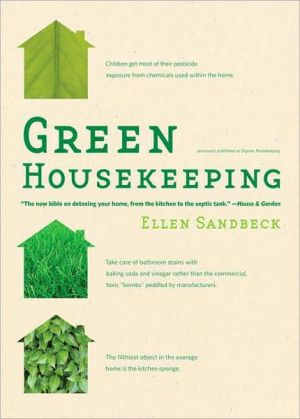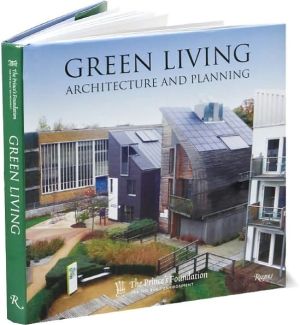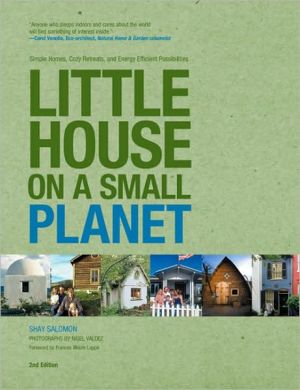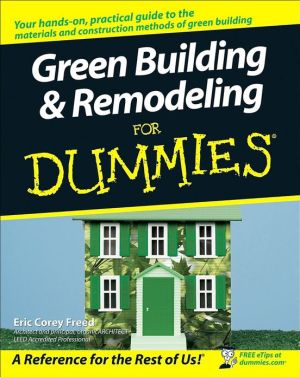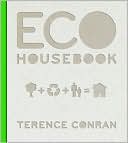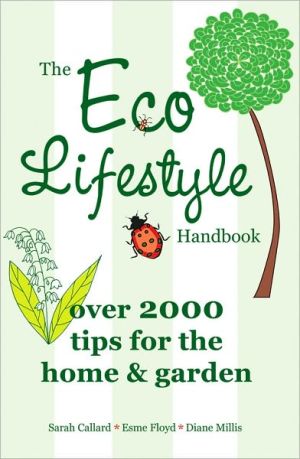Green Housekeeping
A must-have book for the twenty-first-century home..
Search in google:
Want a low-maintenance bathroom that takes 30 seconds a day to clean? Need whiter whites that get whiter for free? Learn to live in a clean, healthy, more economical — and Earth-friendly — way with Ellen Sandbeck's Green Housekeeping, the must-have book for the twenty-first-century home. You will learn to maintain every part of your home — from living room to septic tank, kitchen floor to bathroom sink — using safe, simple cleansers and quick, preventative measures that will save you time and money, save your health, and save the planet. Publishers Weekly According to the EPA, "the air in the average American home is between two and ten times more polluted than the air just outside the threshold." Sandbeck, a onetime housecleaner and roofer, explains why a homemaker must avoid toxins and pesticides if the home is to maintain a balanced, healthy ecosystem. The first chapter-touting the benefits of tidying up and getting organized-is tedious, but the book hits its groove in a chapter on "Organic Cleaning." Here, readers learn that all too often the very products we trust to keep our homes clean contain toxins and antimicrobials that kill beneficial organisms. Sandbeck touches on a wide array of housekeeping issues, sometimes almost straying dangerously off-topic. From preventing mold and mildew and controlling garden pests, to computer care and avoiding electrical fires, Sandbeck doles out knowledge with an easy-to-digest blend of authority and humor. (May) Copyright 2006 Reed Business Information.
Introduction\ Ever since I first began landscaping organically in 1980, friends have been asking me for advice about how to solve problems around the home and garden without using chemicals or breaking too much of a sweat; in 1995, after I first self-published Slug Bread & Beheaded Thistles: Amusing and Useful Techniques for Nontoxic Housekeeping and Gardening, total strangers began contacting me as well. When asked for housekeeping tips, I always made it clear that I was primarily an organic gardener and that the sole focus of my housekeeping was to keep my family healthy and happy. Period. But a couple of years ago, my focus broadened a bit: A few of my friends were unable to maintain control of their homes and the disorder was making them suffer. I spent many long, chatty days helping them clear out and reclaim their living and storage spaces. The profoundly life-changing effects of these cleaning and organizing sessions made me realize that I wanted to write a book about nontoxic housekeeping.\ For several months, my big party joke went something like this: "Guess what the subject of my next book is?" Everyone guessed that I was writing another gardening book. After a well-calculated pause, I would deliver the punch line: "It's about organic housekeeping!" Incredulous and hysterical laughter generally erupted. The joke worked so well because I am one of the least domestic people I know. I prefer to spend as little time as possible doing housework: I would rather dig a ditch than iron a shirt. But on the other hand, my family is extremely healthy; I am quite knowledgeable about managing living systems, controlling pest organisms, and preventing disease; no one has ever gotten sick from my cooking or cleaning; and although both my husband and I had allergies when we were children, our offspring have no allergies at all. After they stopped laughing, most people told me they wanted a copy of the book as soon as it was published. My friends know that if there is an easy, low-maintenance, nontoxic way to accomplish a task, I will find it.\ I have been an organic landscaper, gardener, and worm farmer for most of my adult life. One of my great pleasures is to design and set up a miniature ecosystem, tend and tweak it, and watch it balance itself out. During the years I have repeated this process in dozens of gardens, ranging in size from the tiny to the massive, and with hundreds of worm-composting systems for food waste, ranging in size from under-the-sink to large industrial. My goal with each of these projects has been to design a low-maintenance ecosystem that is as self-sufficient as possible.\ Both a low-maintenance organic garden and a worm composting system depend upon beneficial bacteria, fungi, and other microorganisms to break down organic waste materials, synthesize vital nutrients, and fend off harmful microorganisms. In this way they resemble all other living systems on our planet, whether that system is a prairie, a blue whale, or a human being. Without bacteria, the surface of much of our planet would rapidly be buried under piles of unrotted wood, leaves, and dead animals. But we would not be here to suffer the consequences because, without our intestinal microbes, we would long since have starved to death.\ Unfortunately, many modern cleaning products contain antimicrobial agents. Like all other pesticides, antimicrobials have a tendency to kill off beneficial organisms while allowing harmful ones to proliferate. As they say: "Only the good die young." Our homes are our habitats, and our health depends upon a large population of helper microbes in and on our bodies as well as in our houses.\ My housekeeping philosophy and my gardening philosophy are essentially the same: Evaluate the situation; work with what you have; don't make extra work for yourself; and as much as possible, avoid the use of toxic chemicals. In general, I've found that my attitude mirrors that of people who are the most knowledgeable about the effects of chemicals; all of the chemists, hazardous materials workers, emergency workers, and biological researchers whom I've interviewed avoid using synthetic chemicals in their own homes.\ If we are to thrive physically, our air, water, and food must be clean. If we are to thrive emotionally, our shelter should be a home filled with love. With the exception of clothing, our basic needs are exactly the same as those of other mammals.\ Many of us who live in the developed world have gone well beyond satisfying our basic physical and emotional needs. In fact, we have gone so far that some of those basic needs are no longer being met. We seem to have forgotten what our ancestors knew quite well: The only real reason to do any cleaning at all is in order to maintain our health. If that cleaning happens to make our homes and our clothing look prettier, so much the better. But if we clean just for appearances, rather than for health, we may end up rubbing our burning eyes, scratching our rough, reddened skin, and suffering asthma attacks while wearing soft, fragrant, toxic clothing in gleaming homes that make us dizzy with the aerosolized essence of mountain meadows. Then we can look out the windows and watch the robins fainting on our perfect lawns.\ One spring Emily Dickinson wrote this down: "House is being cleaned. I prefer pestilence."\ Before the twentieth century, housework was a grueling, full-time job that only the wealthiest householders were able to avoid. Carrying water, tending fires, making clothing, and cooking left very little time for other activities. Wood and coal fires and oil lamps produced soot that built up on walls, furniture, and carpeting each winter, making exhaustive spring cleaning a necessity.\ Twentieth-century "labor saving" devices promised to change women's lives beyond recognition. A shirt that used to take months to sew by hand could be machine sewn in a matter of hours; central heating and gas and electric stoves rendered wood piles obsolete; and automatic washing machines and dryers liberated housekeepers from days of heavy labor every week.\ Our predecessors knew that the reasons for doing household chores were to keep their families healthily fed, clothed, and sheltered and to protect the house and its contents from damage caused by pests and the elements. They would be shocked at the extra work we are making for ourselves. If a woman living in 1904 was transported one hundred years into the future and was given a washing machine and dryer, a vacuum cleaner, a sewing machine, a dishwasher, running water, indoor plumbing, electric lights, and a gas or electric stove, would she spend all that saved time fretting over bacteria in her drain or garbage pail, or worrying about whether dust mites inhabited her pillow?\ In 1900, a newborn American's life expectancy was 47 years, but by 2000, it had increased to 74.8 years. This increase is due to the construction of municipal water and sanitation systems and to the development of vaccines. We are no longer dying in droves from diseases caused by poor sanitation; now we are suffering from chronic conditions such as heart disease and diabetes, caused by our affluent and indolent lifestyle, and allergic diseases such as asthma and eczema, which many researchers believe are induced by too much cleanliness. Many of us seem to be suffering from alienation and depression as well.\ Our great-grandmothers' homes were obviously clean enough, or we wouldn't exist. The extra sanitation promised by in-the-tank toilet cleaners, antimicrobial dish liquids, disinfecting sprays, and air fresheners is not making us happier or healthier. There is not a synthetic cleaning product on the market that can improve our health, though there are plenty that can ruin it.\ One thing that our foremothers knew only too well is that housework is tedious, repetitious, and boring. Suggesting that housework is fulfilling or satisfying or that you can get exercise by doing deep knee bends while cleaning is disingenuous. The only rational response is to do housework efficiently and as little as possible, then go out and do something you enjoy.\ In 2002, researchers at the University of Glasgow officially discovered that doing domestic chores lowers people's spirits; all other known forms of exercise elevate them. Professor Nanette Mutrie, who is on the Scottish Executive's national physical task force, said, "With vigorous exercise, the effect is clear; the more you do, the better it is for wellbeing.... With housework it is the opposite — the more you do, the more depression you report."\ We cannot afford to assume that industry has our health and best interests at heart. Dr. Benjamin Rush, a signatory to the Declaration of Independence and America's first surgeon general, wrote, "There is a place in Scotland where madness is sometimes induced by the fumes of lead. Patients who are affected with it bite their hands, and tear the flesh upon other parts of their bodies..." Yet lead was added to gasoline to improve engine performance until 1976, when it was banned by the federal government. Lead was also a common ingredient in house paints until the government banned it in 1977. Inner-city children are still suffering from the effects of exposure to lead-based paints and lead contaminated soils.\ If industry can ignore lead's well-known toxicity, how much more easily can it ignore the as-yet-unknown dangers of newly invented synthetics? More than seventy-five thousand different synthetic chemicals have been formulated in the United States and have been released on to the market and into the environment. An additional two thousand to three thousand new chemicals are introduced each year. Not even the most brilliant and dedicated chemist could possibly keep track of all of them. How can a lay person hope to be well informed enough to make intelligent choices about which products to buy and which to avoid?\ I was underwhelmed when I read a December 21, 2000, news release from the U.S. Environmental Protection Agency (EPA), which began as follows: "As part of EPA's commitment to increase chemical information, two notices have been issued directed at voluntary expansion of health and safety testing of chemicals." The release announced the establishment of the Voluntary Children's Chemical Evaluation Program. It continued, "The program identifies 23 chemicals on which manufacturers will be asked to voluntarily generate key testing information. These 23 chemicals were selected because monitoring studies found them present in human tissue samples."\ The news release included the announcement of the High Production Volume Challenge program, "...which called on the U.S. chemical industry to voluntarily commit to providing the public with basic health and safety data on the 2,800 chemicals produced in highest volume."\ Those twenty-three questionable chemicals are already lodged in my body, but I don't remember volunteering to be a chemical guinea pig. One can only wonder why our government is politely asking the manufacturers to volunteer to test their own products for safety.\ The 1998 Chemical Hazard Data Availability Study, which is posted on the Environmental Protection Agency's website, stated, "Most Americans would assume that basic toxicity testing is available and that all chemicals in commerce today are safe. A recent EPA study has found that this is not a prudent assumption." This is an interesting statement, especially coming as it does from a governmental agency whose official mission is "...to protect human health and the environment."\ The EPA looked at a set of 491 chemicals found in commonly used consumer products and found that only 25 percent of them had been tested for toxicity. According to this report, it would cost $427 million to test the toxicity of all of the most commonly used chemicals, a figure equal to "0.2% of the total annual sales of the top 100 U.S. chemical companies." Why hasn't the U.S. government required that this testing be done? Perhaps our ignorance is the chemical companies' bli$$.\ In the United States, chemicals — like criminal defendants — are assumed innocent until proven guilty. Only chemicals that have been proven dangerous beyond a reasonable doubt are removed from the market.\ The Stockholm Treaty on dangerous persistent organic pollutants (POPs), which was signed by 151 nations including the United States, became legally binding on May 17, 2004. The treaty bans the so-called Dirty Dozen of the most dangerous synthetic chemicals. They are aldrin, chlordane, DDT, dieldrin, endrin, heptachlor, mirex, toxaphene, polychlorinated biphenyls (PCBs), hexachlorobenzene, dioxins, and furans.\ Klaus Toepfer, executive director of the United Nations Environment Programme (UNEP), said, "For decades these highly toxic chemicals have killed and injured people and wildlife by inducing cancer and damaging the nervous, reproductive and immune systems. They have also caused uncounted birth defects."\ If it took decades to remove these horrifyingly dangerous chemicals from the market, how long might it take to ban a chemical that was merely dangerous? The surest way to protect yourself and your family from the dangers of toxic synthetic chemicals is to choose products made of safe, natural, and preferably food-grade ingredients.\ Modern dwellings may contain many synthetic products that can be hazardous to the health. These products can be divided into two categories: those that are built into the house and its furnishings, which can be expensive and time consuming to replace, and consumer products that are used up and replaced on a regular basis, such as toiletries, cleaning supplies, clothing, and bedding. It is relatively easy and inexpensive to switch to nontoxic versions of these consumable products, and the health benefits can be enormous.\ Most of this book deals with these easily replaceable, nondurable goods. But it is important to understand the more permanent toxins that lurk in our homes so that we can make informed decisions when we need to replace our more durable belongings.\ A quick overview of the average American home may reveal the following toxins:\ Living room: Volatile organic compounds (VOCs), which can outgas for five years from new furniture, carpets, carpet pads, upholstery, curtains and paneling; fabric and carpet waterproofing and stain proofing treatments (fluoropolymers); furniture polish; and antique mercury barometer. \ Kitchen: Formaldehyde outgassing from particleboard in new cabinets and countertops, toxic gases produced by overheated nonstick cookware, mold and mildew growing under the sink, carbon monoxide emitted from a stove that isn't functioning properly, polycarbonate milk and juice bottles in the refrigerator, plastic-lined tin cans, vinyl flooring, chlorine-bleach scouring powder, antimicrobial dish liquid, chlorine-based dishwasher detergent, spray disinfectant, one-serving microwaveable plastic foam bowls, plastic food wrap, all-purpose cleaner, bleach, drain cleaner, floor wax, oven cleaner, metal polish, lead-glazed dishes, lead crystal decanters, and pewter drinking mugs.\ Utility closet: Carpet cleaner, room deodorizer, and mothballs.\ Bathroom: Chlorine-based cleansers, toilet bowl cleaners and disinfectants, drain cleaner, room deodorants, antimicrobial soap, body and hair care products, antiperspirants, lotions, cosmetics and perfumes that contain endocrine-disrupting chemicals, mold and mildew, PVC plumbing pipes, and mercury thermometer.\ Bedroom: Freshly dry-cleaned clothing emitting perchloroethylene fumes in the closet, mattress outgassing formaldehyde, stain repellent, flame retardant, dust-mite insecticide, wrinkle-resistant sheets, and curtains and clothing emitting formaldehyde fumes.\ Basement, garage, workshop: Gasoline, solvents, paints, paint thinner, lubricants, antifreeze, caulk, glue, lacquer, pesticides, herbicides, degreasers, spray paint, water sealant, rubber cement, turpentine, mineral spirits, lighter fluid, and mold.\ Laundry room: Spot removers, chlorine bleach, perfumed fabric softeners and detergents, spray starch.\ Older homes: Lead-based paint.\ \ Obviously, it's easy to end up with an impressive collection of toxins unless you're selective and creative in your approach to housekeeping. Though the advertisers would like us to believe otherwise, most cleaning products are completely unnecessary and easily replaced with common ingredients that may already be in your pantry or cupboard. Throughout this book, you'll find information on recommended equipment and supplies as well as many nontoxic, timesaving cleaning techniques. In addition, at the end there's a complete bibliography and list of sources and websites that contain information on topics ranging from fire safety and hazardous materials to insulating paint and self-cleaning windows.\ They say that if you haven't got your health, you haven't got anything, but I would like to add that once you have your health, having a little space, time, and money is nice as well. Environmentally sound housekeeping minimizes the household's negative impact on the environment. This approach generally leads to fewer things in a house, and thus more open space; having fewer possessions means you're spending less time taking care of them; and buying fewer things saves money. What could be better than being healthy and having more time, money, and space to enjoy?\ A home can be developed into a balanced ecosystem, just as a garden can. The biggest difference between interior and exterior ecosystems is that the outdoor ones are largely self-cleaning, while interior ecosystems are not. Because many natural processes are excluded from the indoor habitat, humans have had to perfect activities such as taking out the garbage to do the work of decomposers, and washing the dishes and dusting to replace the cleaning properties of the excluded wind, rain, and snow.\ In the pages ahead you'll find all of the information you need to create your own healthy, balanced ecosystem with a minimum of fuss. Knowledge is power. Read on.\ Copyright © 2006 by Ellen Sandbeck
ContentsIntroductionChapter One: First Things FirstModeration in All ThingsOrganizingA Place for EverythingIf You Can't Find It, You Might as Well Not Own ItHome Maintenance ProtocolsLabeling ToolsJunk Drawers and Miscellaneous StorageAbsentmindednessToo Much StuffPhotosSorting PapersIf You Ask Them, They Will ComeBanishing ChaosHiring HelpCleaning Outbuildings and Extremely Chaotic HousesPost-Clutterectomy CareStorage ProtocolHabitsYou Are What You Do; You Are What You ThinkSetting Orderly HabitsLiving Lightly and HappilyWaste PreventionReuseRecycling: Reducing Things to Their Basic ElementsThe FutureKeep MovingChapter Two: The Kitchen: You Are What You EatKitchens R UsOrganic CleaningWhat Is Clean?The ProductsCleaning ToolsWham, Bam, Thank You Ma'amMopping UpGet SteamedSteaming Floors and CountersEnvironmentally Friendly DishwashingDishwashing SuppliesDishwasher TechniqueWashing Dishes by Hand, Saving WaterKitchen OdorsEliminate OdorsAdd Better SmellsGrowing Clean AirSink CleaningStainless-Steel CarePorcelain Enamel SinksArtificial Stone, Corian, or Acrylic SinksFaucetsDown the DrainDrain SnakeChoosing a RefrigeratorFridge MaintenanceClean, Clean the RangeOven Grime PreventionSafer Oven CleaningCleaning the Oven by HandSteam Cleaning the OvenThe StovetopCleaning the StovetopThe Range HoodThe MicrowaveGeneral CleaningToasterShock PreventionFire PreventionPolishingCoffee Makers, Teapots, and KettlesWhy BuyOrganic Food?Save Your Health and Your MoneyPreventing Food PoisoningReal Cleaning for Real KitchensThe Really Scary BacteriaOily PoisonCarnivore's Food SafetySafe Meat HandlingUnderstanding the EnemyFashionable DiseasesParasitesChoosing FishPutrescine, Cadaverine, and Histamine — The Rotten Meat SistersFending Off SpoilageNot So Raw, PleaseAntibiotics, Breakfast of ChampionsProbiotics for PeopleFood ChoicesClean CookingImplementing a Domestic Spray ProgramIt's Mostly in the TimingClean and DryKitchen LaundryChoosing CookwareFlexible BakewareCaring for Stovetop CookwareUnsafe at Any HeatSilver CareMicrowaveable ContainersFood PackagingChapter Three: The Low-Maintenance BathroomDesigning a Low-Maintenance Bathroom from the Bottom UpFloorsWalls and CeilingStorageSoft vs. Hard WaterHot WaterMaterialsColors and FinishesChoosing HardwareGrime Prevention and Cleaning TechniquesToolsBath TowelsChoosing a Scum Free SoapCleaning the Shower While ShoweringToilet Grime PreventionProper Toilet EtiquetteClog BustingNontoxic, Timesaving Cleaning TechniquesCleaning MethodsRoutine CleaningSpecial Circumstances CleaningSmellsDefine CleanPersonal Care ProductsSome Dangerous Common Ingredients in Synthetic Beauty ProductsHomegrown BeautyChapter Four: The BedroomCleaning PillowsMaintaining Down-Filled Comforters, Quilts, and FeatherbedsHow Often Should the Bed Linens Be Changed?Blankets and ComfortersBlanket MaintenanceMattressesFire "Safe" but Still DangerousUnstained Yet UnhealthyChoosing a MattressMattress FlippingStain PreventionOdor EradicationWell-Preserved but UnhealthySheets and PillowcasesClean Air ChoicesChapter Five: LaundryGreat-Grandma's WashdayThe Beauty of the Lowered StandardChoosing the EquipmentA Few Words About LintWater and Energy UseSortingBy Color, Three Degrees of SeparationBy Sturdiness, Two Degrees of SeparationBy Dirtiness, Four Degrees of SeparationHampering Rips, Tears, Stains, and Broken ZippersInside OutWashing FrequencySoap vs. DetergentAnything but White...Laundry Balls and Discs, the Handy Little Devices that Clean Out Your Wallet and Leave Your Laundry DirtyGeneral WhiteningRecommended Laundry AidsBoraxWashing SodaDistilled VinegarBluingFabric SoftenersStain RemovalProtein-Based StainsSweat StainsOil-Based StainsVegetable-Pigment (Tannin) StainsDye StainsPencilPaintRustDry CleaningDry Cleaning ComparisonsFabric CareSynthetic FibersPlant FibersAnimal FibersRain WashingLetting the Rain Blow through Your ClothesSnow CleaningTo Snow-Clean Woolen GarmentsStoring WoolensBeddingDown MaintenanceDrying TechniquesPreferred EquipmentOutdoor Line DryingIndoor Line DryingStretched TrousersIroningDo Not Iron, Do Not StarchA Message from the Department of Redundancy DepartmentRoughing ItGrime Prevention for Sleeping BagsIt All Comes Out in the Wash...Chapter Six: General CleaningThe Well-Tempered HouseHealthy DecorCarpeting and RugsCarpet ChoicesLocation, Location, LocationThe Carpeting SolutionWindow CoveringsWindow BlindsBuilding Materials and FurnitureChoosing Upholstery and Drapery FabricsHarmonizingAnnoying Building SyndromeCleaning MethodsRug and Carpet Care, with a Little Upholstery Thrown InWalls and CeilingsWashing WindowsDustingDusting, Cleaning, Oiling, and Polishing Wooden FurnitureComputersComputer CareComputer SpillsCreative TensionChapter Seven: Indoor Air QualityDomestic Odor ControlAnimal OdorsIndoor Air PollutantsGaseous PollutantsIndoor Pollution ControlOut with the Old Air, In with the NewRemoval or FilteringWatery AirPreventing Fungi, Mold, and MildewHome MaintenanceRoutine HouseworkCirculationVanquish Evil Dampness with Dehumidifiers or Air ConditionersHumidifiersAlternative Humidifiers and Air CleanersThe Air ScoutsChapter Eight: Hazardous Materials, Fire Safety, Home Maintenance, Automotive CareHazardous MaterialsSome Advice from a Guy Who Picks Up the PiecesHazardous Materials Disaster PreventionHazardous Materials Disposal ProgramsRead the Label, Then You Won't Need to WeepAge-Induced InstabilityRepacking for the TripWhen to Call for HelpFire SafetyArise! Awake!Fire 101From Small Sparks, Huge Fires GrowThe Grand Prize Fire StarterCooking Up an Ounce of PreventionMicrowave Fire PreventionBarbequeThe Next Biggest Fire ThingCarbon MonoxideElectrical FiresLighting SafetySpontaneity Is Not Always a Good Thing...What Firefighters Want You to KnowThe Firefighters' "Perfect" Dream HomeWhen Prevention FailsA Quenching ShowerWater, Mother Nature's Fire ControlMoney Makes the World Go AroundHome MaintenancePaint PurchasingAerosol PaintsWatch Out for That Can!Safe CleanupPaint PollutionRemoving Old WallpaperCleaning Wooden DecksKilling Moss on Wooden ShinglesDigging OutsideIce and SnowThe Nuts and Bolts of Rust RemovalAutomotive CareNo Fires, No Floods, No Explosions — and They Lived Happily Ever AfterChapter Nine: In and Around the GardenReducing Toxic RunoffHome TreatmentBuilding a Rain GardenRain Barrels: Saving for a Dry Day Permeable PavementContaminated SoilCompostVermicompostingMulchThe Value of TreesControlling Global WarmingControlling Local WarmingLawnsLawn AlternativesMowingSafe Garden HosesWeed ControlEvicting Itchy and ScratchyPickled WeedsPoisonous PlantsWarm Climate or HouseplantsDecorativeOutsideGarden Pest Control: Of Mice and MenWe Are All Siblings Under the Skin, Exoskeleton, or BarkA Clean Safe KillDon't Judge by AppearancesInsect Control with BackbonePickled Slugs and SnailsGarbage Can SecurityIndoor/Outdoor PestsBeing Chased by the FuriesAnts IndoorsAnts OutdoorsCockroachesInfested FoodMice, Rats, and SquirrelsFliesTermitesClothes MothsBloodsuckersMosquitoesFrom the Counterproductive Department: Mosquito AttractantsTicksFleasPet CareEar MitesCleaning Up Pet HairCat Litter BoxesPet SafetyPet BirdsBaby-ProofingProtecting the House from the ChildrenCleaning TricksLiceClosing the CircleBibliographyIndex
\ Publishers WeeklyAccording to the EPA, "the air in the average American home is between two and ten times more polluted than the air just outside the threshold." Sandbeck, a onetime housecleaner and roofer, explains why a homemaker must avoid toxins and pesticides if the home is to maintain a balanced, healthy ecosystem. The first chapter-touting the benefits of tidying up and getting organized-is tedious, but the book hits its groove in a chapter on "Organic Cleaning." Here, readers learn that all too often the very products we trust to keep our homes clean contain toxins and antimicrobials that kill beneficial organisms. Sandbeck touches on a wide array of housekeeping issues, sometimes almost straying dangerously off-topic. From preventing mold and mildew and controlling garden pests, to computer care and avoiding electrical fires, Sandbeck doles out knowledge with an easy-to-digest blend of authority and humor. (May) Copyright 2006 Reed Business Information.\ \
